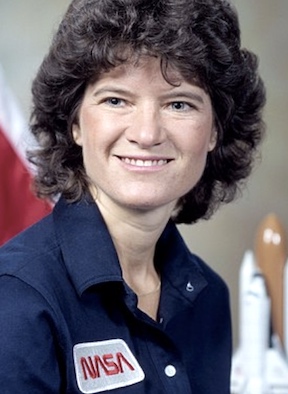On this date in 1951, astronaut Sally Kristen Ride was born in Los Angeles, the firstborn child of Carol (née Anderson) and Dale Ride. She had one sibling, Karen, known as “Bear” throughout her life. Both parents were elders in the Presbyterian Church. Her mother worked as a volunteer counselor at a women’s correctional facility and taught Sunday school. Her father became a political science professor at Santa Monica College after his military service.
After high school, she enrolled at Swarthmore College in Pennsylvania on a full scholarship. She played field hockey, golf and, most competitively, tennis. After three semesters she transferred to UCLA, where she was the only female physics major.
Dropping her goal of playing professional tennis, she transferred to Stanford University, graduating in 1973 with a B.S. in physics and a B.A. in English literature. She then earned an M.S. in physics and a doctorate in philosophy in 1978. Astrophysics and free-electron lasers were her areas of study. She wrote her doctoral dissertation on “the interaction of X-rays with the interstellar medium.”
Ride’s application to become an astronaut was one of 8,079 received, and in 1978 she was chosen by NASA with five other women to join the group of 35 new recruits. After serving as a ground-based mission specialist on two launches, at age 32 she became the first American woman to fly into space aboard the Space Shuttle Challenger in 1983. Counting her second Challenger flight in 1984, she spent 343 hours in space.
Asked by Gloria Steinem in 1983 about “the dumbest kinds of questions you’ve been asked to date,” Ride said with a laugh: “Without a doubt, I think the worst question that I’ve gotten was whether I cried when we got malfunctions in the simulator. No.” (Steinem’s ABC-TV series “In Conversation With…”) She also said in the interview that “I wouldn’t even say that I’m spiritual. I honestly don’t think about religion at all.”
“Our parents taught us to explore, and we did,” her sister Bear would say later. “Sally studied science and I went to seminary. She became an astronaut and I was ordained as a Presbyterian minister. … Sally’s signature statement was ‘Reach for the Stars.’ Surely she did this, and she blazed a trail for all the rest of us.” (NBC News, July 24, 2012)
After dating astronaut Robert “Hoot” Gibson, in 1982 she married Steven Hawley, a member of her group of astronaut recruits. Bear Ride and Hawley’s minister father officiated. Ride and Hawley divorced in 1987.
Ride’s scheduled third flight was canceled when tragedy struck and the Space Shuttle Challenger blew up 73 seconds after launch on Jan. 28, 1986. All seven aboard died, including teacher-in-space Christa McAuliffe and astronaut Judith Resnik, who in 1984 was the second American woman in space.
Ride was appointed to the Rogers Commission investigating the disaster and was critical of NASA’s risk-assessment processes. She and Richard Feynman were instrumental in doggedly pursuing and helping reveal the cause of the explosion, the leaking O-ring seals on the booster rocket that let highly flammable gases escape.
After leaving NASA, she joined the physics faculty at the University of California-San Diego and led public outreach programs in cooperation with the Jet Propulsion Laboratory in Pasadena. She served in 1999-2000 as president of Space.com, a company that aggregated news online about science and space. She then became president and CEO of Sally Ride Science, which she co-founded with Tam O’Shaughnessy to create programs and publications for upper elementary and middle school students, with a particular focus on girls.
After Ride was diagnosed in 2011 with pancreatic cancer, she and O’Shaughnessy registered their domestic partnership. She died at age 61 at home in 2012, with her cremains buried next to her father in a Santa Monica cemetery. Her obituary publicly revealed for the first time that O’Shaughnessy had been her partner for 27 years, which made Ride the first known LGBTQ+ astronaut.
Bear Ride confirmed the relationship, saying her sister chose to keep her personal life private, including her cancer and 17 months of debilitating treatments. “Sally lived her life to the fullest with boundless energy, curiosity, intelligence, passion, joy and love. Her integrity was absolute; her spirit was immeasurable; her approach to life was fearless. Sally died the same way she lived: without fear.” (Ibid., NBC News) (D. 2012)
PHOTO: Ride in 1984.


